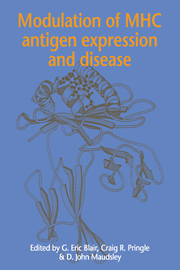Book contents
- Frontmatter
- Contents
- List of contributors
- Preface
- List of abbreviations
- 1 General introduction to the MHC
- 2 Organization of the MHC
- 3 Interactions of cytokines in the regulation of MHC class I and class II antigen expression
- 4 Control of MHC class I gene expression
- 5 Control of MHC class II gene expression
- 6 Modulation of MHC antigen expression by viruses
- 7 Modulation of MHC antigen expression by retroviruses
- 8 Modulation of MHC class I antigen expression in adenovirus infection and transformation
- 9 MHC expression in HPV-associated cervical cancer
- 10 Inhibition of the cellular response to interferon by hepatitis B virus polymerase
- 11 Cellular adhesion molecules and MHC antigens in cells infected with Epstein-Barr virus: implications for immune recognition
- 12 Effect of human cytomegalovirus infection on the expression of MHC class I antigens and adhesion molecules: potential role in immune evasion and immunopathology
- 13 Oncogenes and MHC class I expression
- 14 Mechanisms of tumour cell killing and the role of MHC antigens in experimental model systems
- 15 Manipulation of MHC antigens by gene transfection and cytokine stimulation: a possible approach for pre-selection of suitable patients for cytokine therapy
- 16 Overexpression of MHC proteins in pancreatic islets: a link between cytokines, viruses, the breach of tolerance and insulindependent diabetes mellitus?
- 17 The role of cytokines in contributing to MHC antigen expression in rheumatoid arthritis
- 18 Expression of an MHC antigen in the central nervous system: an animal model for demyelinating diseases
- Index
13 - Oncogenes and MHC class I expression
Published online by Cambridge University Press: 11 September 2009
- Frontmatter
- Contents
- List of contributors
- Preface
- List of abbreviations
- 1 General introduction to the MHC
- 2 Organization of the MHC
- 3 Interactions of cytokines in the regulation of MHC class I and class II antigen expression
- 4 Control of MHC class I gene expression
- 5 Control of MHC class II gene expression
- 6 Modulation of MHC antigen expression by viruses
- 7 Modulation of MHC antigen expression by retroviruses
- 8 Modulation of MHC class I antigen expression in adenovirus infection and transformation
- 9 MHC expression in HPV-associated cervical cancer
- 10 Inhibition of the cellular response to interferon by hepatitis B virus polymerase
- 11 Cellular adhesion molecules and MHC antigens in cells infected with Epstein-Barr virus: implications for immune recognition
- 12 Effect of human cytomegalovirus infection on the expression of MHC class I antigens and adhesion molecules: potential role in immune evasion and immunopathology
- 13 Oncogenes and MHC class I expression
- 14 Mechanisms of tumour cell killing and the role of MHC antigens in experimental model systems
- 15 Manipulation of MHC antigens by gene transfection and cytokine stimulation: a possible approach for pre-selection of suitable patients for cytokine therapy
- 16 Overexpression of MHC proteins in pancreatic islets: a link between cytokines, viruses, the breach of tolerance and insulindependent diabetes mellitus?
- 17 The role of cytokines in contributing to MHC antigen expression in rheumatoid arthritis
- 18 Expression of an MHC antigen in the central nervous system: an animal model for demyelinating diseases
- Index
Summary
Introduction: immune recognition of tumour cells
In the late 1980s it became clear that cancer cells develop by multiple genetic alterations (reviewed in Weinberg, 1989; Bishop, 1991). These alterations include activation of proto-oncogenes as well as inactivation of tumour suppressor genes. Proto-oncogenes, more commonly called oncogenes, exert important functions in cell proliferation and differentiation and their activity is usually tightly controlled to ensure a minimal risk of inappropriate activity. Activation of oncogenes in animal and human tumours may occur through several mechanisms including amplification, elevated expression and point mutations. These genetic alterations usually result in an altered activity of the oncogene-encoded protein and this contributes to uncontrolled proliferation.
In the light of the crucial role that HLA class I antigens play in the interaction of altered self antigens or viral antigens with CTLs (see Chapter 1), one would expect that antigens specifically present in tumours are presented by HLA class I molecules. Such antigens might be viral antigens in the case of virally induced tumours or altered self proteins in the case of tumours induced by xenobiotics like carcinogens or radiation. In numerous animal and human tumours, mutations in oncogenes have been shown to be responsible for the tumorigenic properties of the tumour cell. These mutations are potential targets for recognition by the immune system of the host. Candidate oncogene and tumour suppressor proteins are ras and p53 proteins, respectively; these can be activated by various mutations and are involved in many forms of human cancer (reviewed in Bos, 1989; Levine, Momand & Finlay, 1991).
- Type
- Chapter
- Information
- Modulation of MHC Antigen Expression and Disease , pp. 295 - 314Publisher: Cambridge University PressPrint publication year: 1995
- 1
- Cited by



